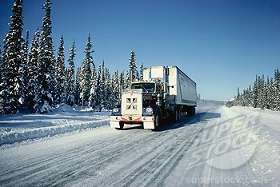Another Nitpicky High Road Question
Topic 6796 | Page 1

Just to be clear... i was calling my question nitpicky, not the high road questions
Yeah, here's the quote from the CDL Manual:
Do not drive with a tire that is leaking or flat except to the nearest safe place to repair it. Remove any overheated tire and place it at a safe distance from your vehicle. Do not drive until you correct the cause of the overheating. Follow all rules about parking and attending placarded vehicles when checking, repairing or replacing tires
And your question:
Is a driver normally equipped to remove any tire on a truck, let alone an overheated one?
No you won't be able to remove it yourself. The manual said "Do not drive with a tire that is leaking or flat except to the nearest safe place to repair it." ... so I believe they mean once you get to the repair shop or the roadside mechanic comes out the tire should be removed and taken a safe distance away from the Hazmat load.
CDL:
Commercial Driver's License (CDL)
A CDL is required to drive any of the following vehicles:
- Any combination of vehicles with a gross combined weight rating (GCWR) of 26,001 or more pounds, providing the gross vehicle weight rating (GVWR) of the vehicle being towed is in excess of 10,000 pounds.
- Any single vehicle with a GVWR of 26,001 or more pounds, or any such vehicle towing another not in excess of 10,000 pounds.
- Any vehicle, regardless of size, designed to transport 16 or more persons, including the driver.
- Any vehicle required by federal regulations to be placarded while transporting hazardous materials.
HAZMAT:
Hazardous Materials
Explosive, flammable, poisonous or otherwise potentially dangerous cargo. Large amounts of especially hazardous cargo are required to be placarded under HAZMAT regulations
New Reply:
New! Check out our help videos for a better understanding of our forum features

















Preview:
This topic has the following tags:
HAZMAT High Road Training Program







 TT On Facebook
TT On Facebook
High Road question from page 74 (I think) ... the last option, d, is the correct answer...
While driving a placarded vehicle and a tire overheats, what should you do?
a) Immediately call the emergency response number you were supplied with
b) Use water to prevent a fire
c) Use a fire extinguisher to cool it
d) Remove any overheated tire and place it a safe distance from the vehicle
My question: Is a driver normally equipped to remove any tire on a truck, let alone an overheated one?
I think I would use water to cool it, if available, and then call my dispatcher for help...
Dispatcher:
Dispatcher, Fleet Manager, Driver Manager
The primary person a driver communicates with at his/her company. A dispatcher can play many roles, depending on the company's structure. Dispatchers may assign freight, file requests for home time, relay messages between the driver and management, inform customer service of any delays, change appointment times, and report information to the load planners.